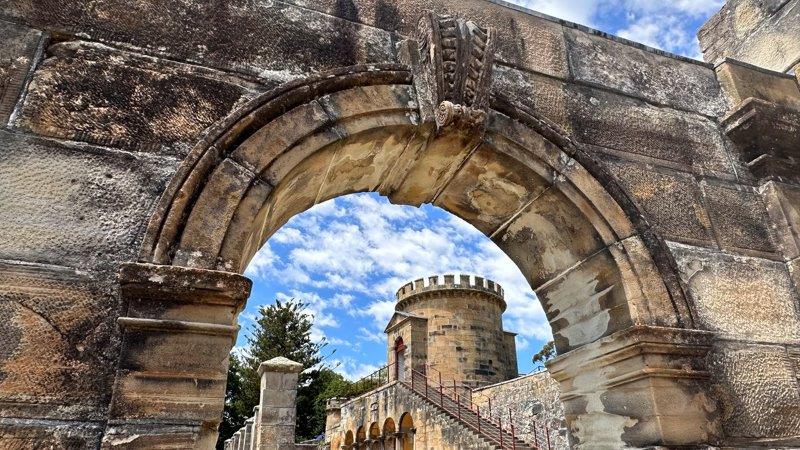We drove the car and caravan onto the Spirit of Tasmania ferry in Geelong, and 11 hours later…
We arrived at Devonport Harbour in Tasmania. During the sail we crossed the Bass Strait, renowned to get very bumpy at times. We did a night sail, and had a very smooth arrival early the next morning. We were very impressed with the logistics in Geelong and Devonport, and the comfort and facilities on the ferry.

From Devonport, we headed in a southern direction to Hobart. This was easy highway driving conditions and two hours later we were at our first campsite in Campbell Town. From this free council park, you can cross the river straight into the main business area.
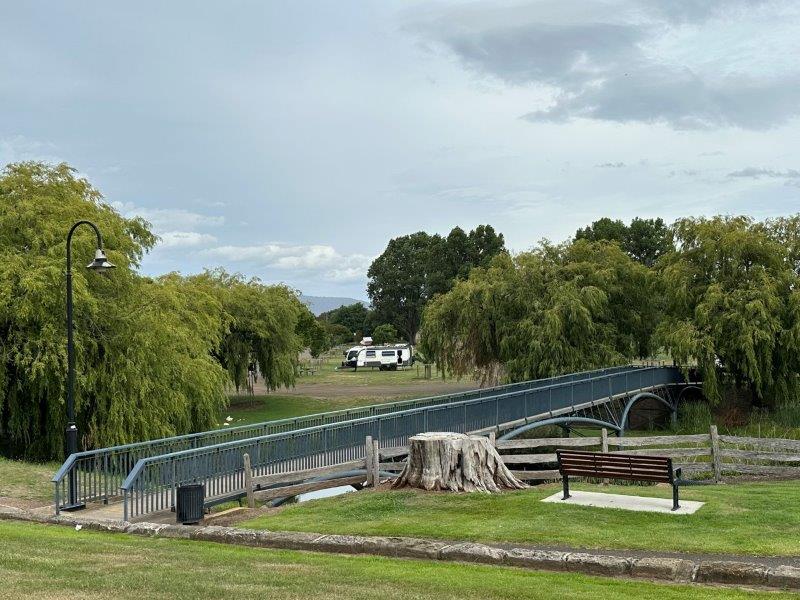
Across the park is a day use area with a massive wooden sculpture depicting the town’s history and some of it’s most influential people.
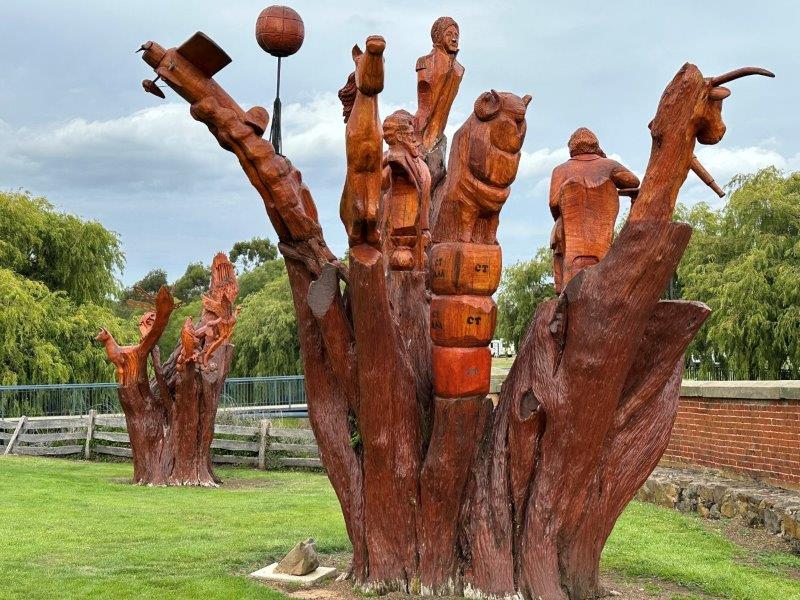
The town is considered one of five Georgian towns in Tasmania with a well-preserved main street. You can’t miss the Red Bridge built by convicts in 1838. The Bridge is still the main route across the Elizabeth river.
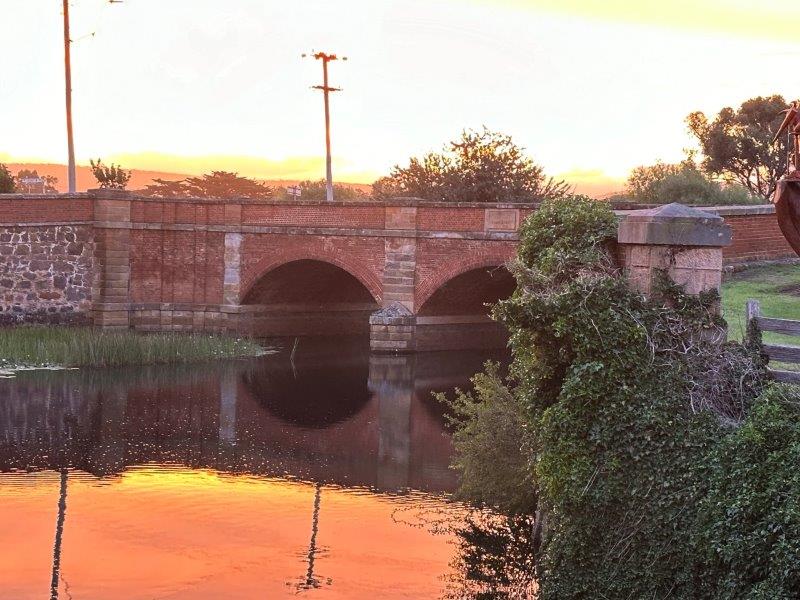
The main road of Campbell Town is lined with red, inscribed bricks. These bricks have basic details of the convicts deported from the United Kingdom to Australia.
After reading a few of the bricks, it became clear that the value and justice systems have changed over time. As seen below, you would get a prison sentence of seven years for “child stealing” and ironically a life sentence for “stealing liquor”. It does provide an insight to the priorities at the time.
While we were strolling along the the convict brick trail, a local passer by said: “Looking for your relatives, are you?”

In the neighbouring town Ross, we saw this colourful garden.
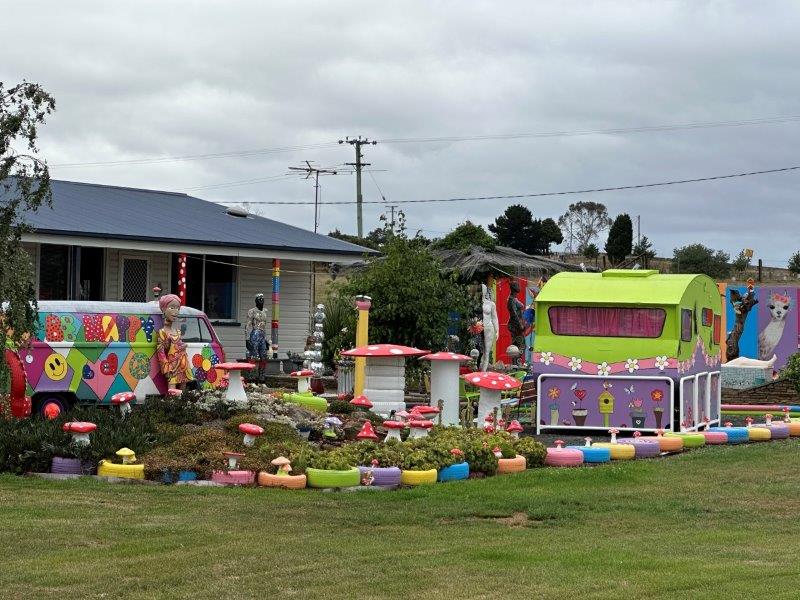
The garden was fenced to match.
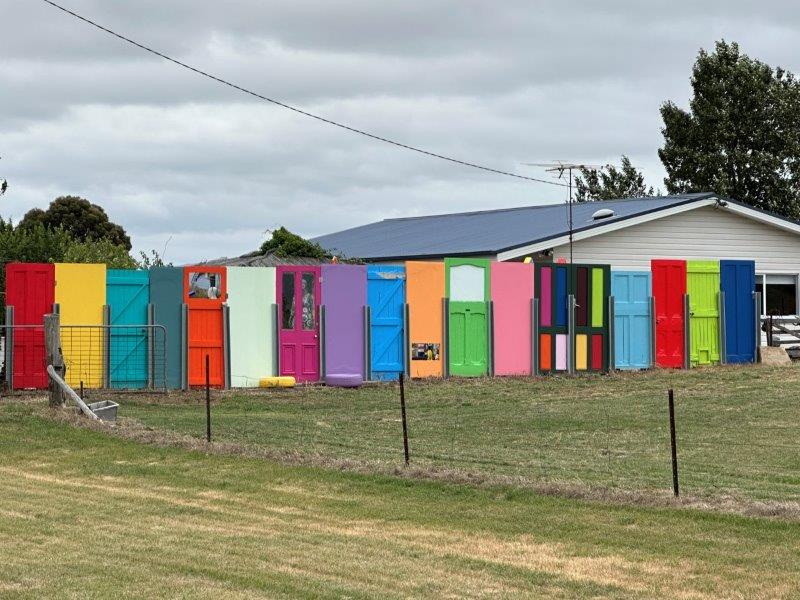
We drove over an 1836 bridge still in daily use as one of the main entrances into Ross. The masonry skills on this bridge must be among the best we have seen in Australia.
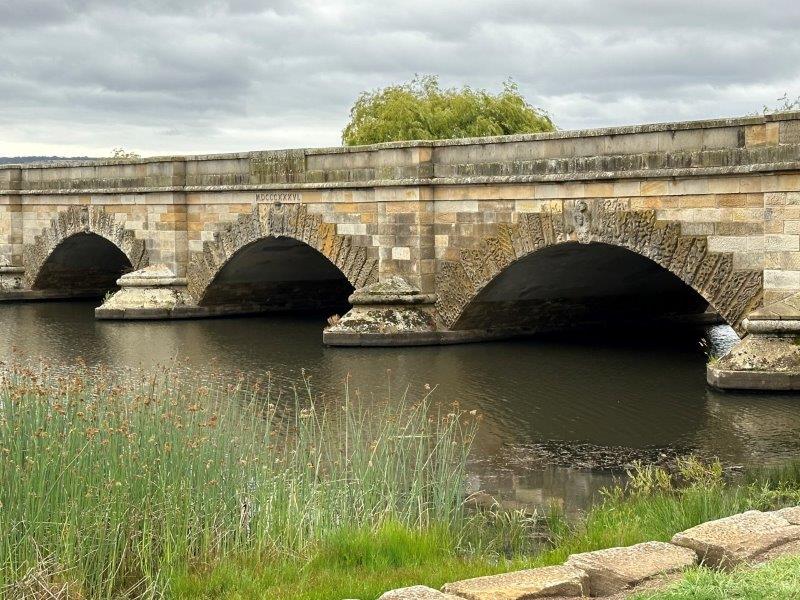
After leaving Campbell town, we headed to Hobart. In Hobart we veered right to Lonnavale. We booked into River’s Edge Wilderness Camping. This was a paid camp with power, water and amenities. We booked this site as our kids were flying into Hobart to visit us for a few days.

It was great spending a few relaxed days with family on the riverside next to the campfire.

As a daytrip form Lonnavale, we visited Hastings Caves State Reserve. After parking, we took a quick stroll to the cave.
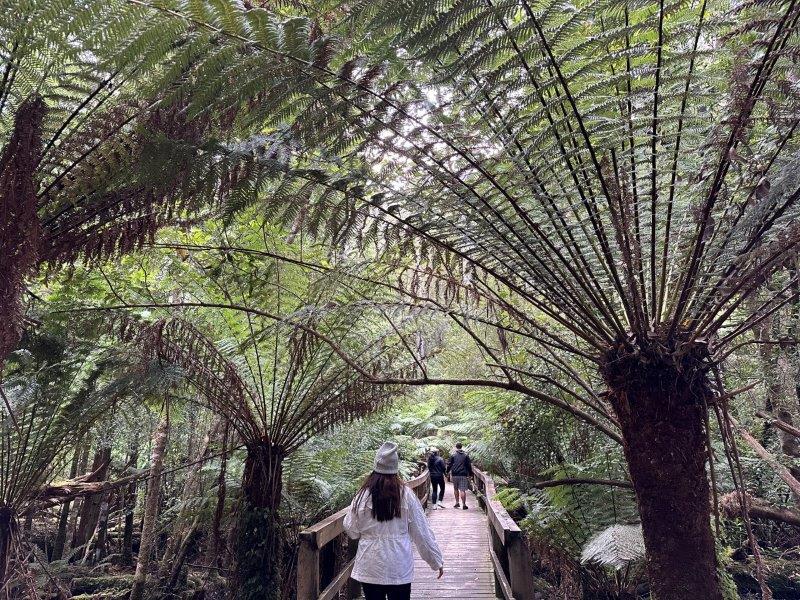
You have to book a guided tour to enter the Newdegate Cave. This was a great cave, and a very informative tour. The cave boasts stunning chambers with subterranean formations and even rare helictites.
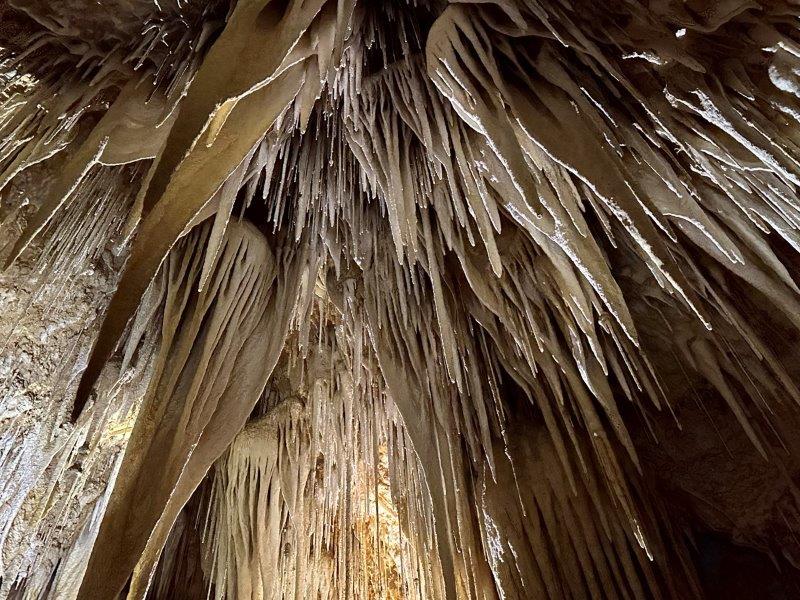
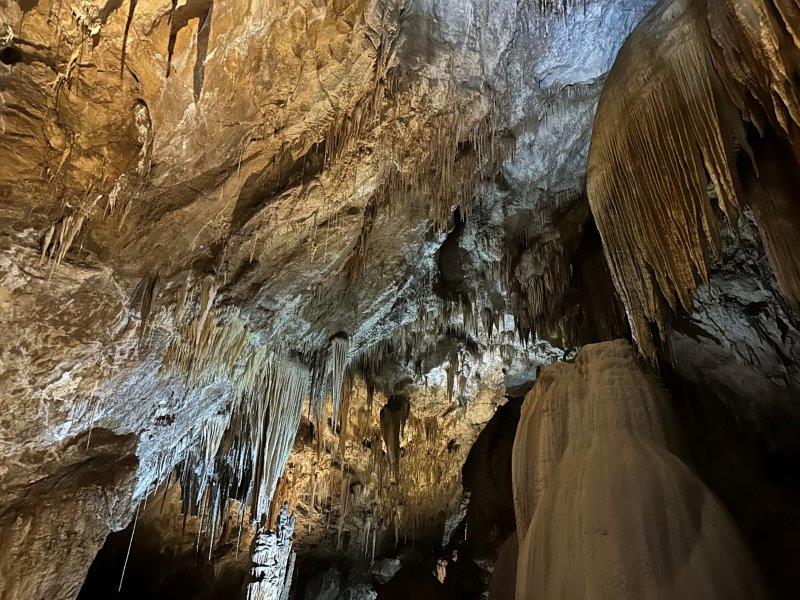
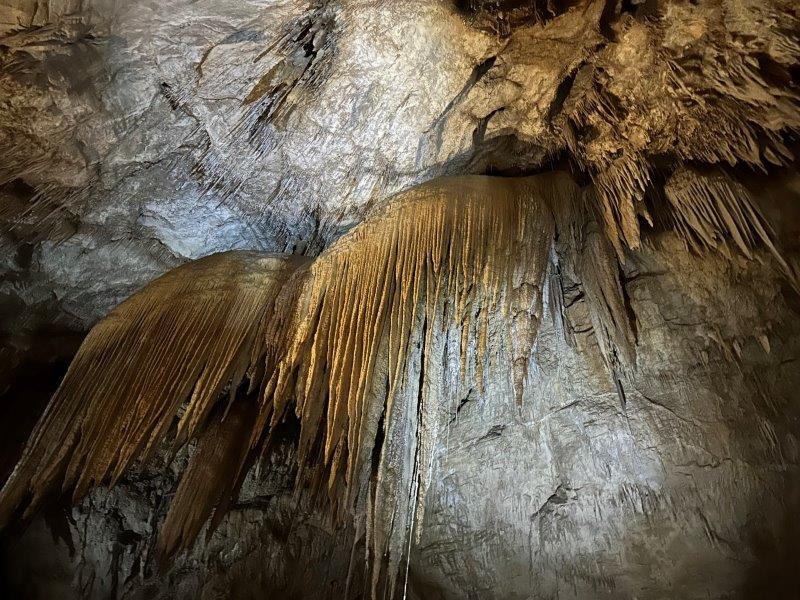

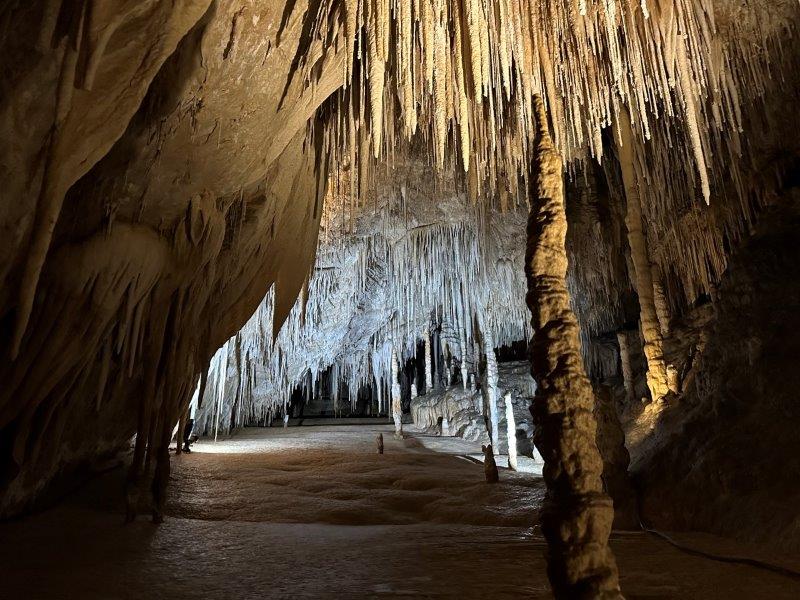
After the Newdegate Cave tour, we went back to the Information Centre. From there, we could go for a dip in the 28° thermal pool and also do the Platypus Walk. We decided to do the Platypus Walk as beanies and scarfs were better suited to the weather.
On the track was an arch where the runoff from the hot creek feeding the thermal pool, and cold creeks meet.
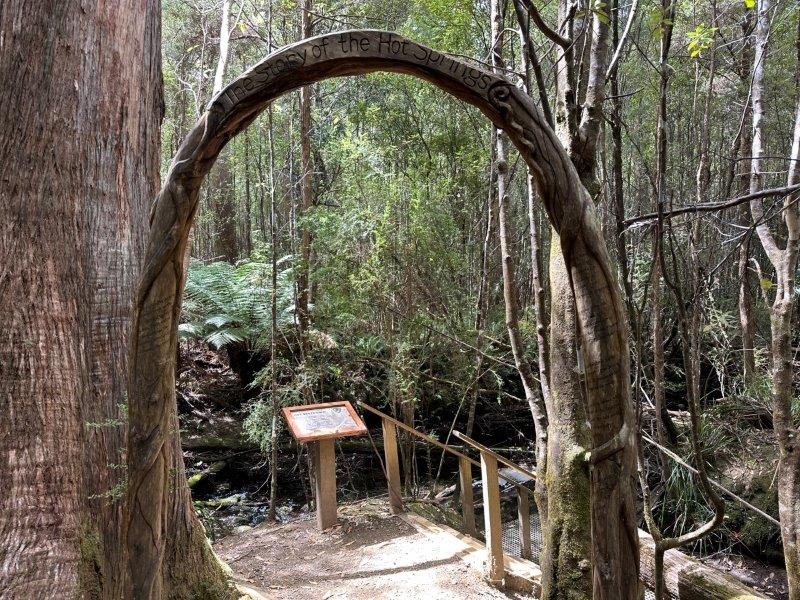
After the arch, the change in vegetation was noticeable.

Our next stop was Geeveston. We based ourselves here for a week to explore the southern part of Tasmania. You can’t miss the entrance to the town.
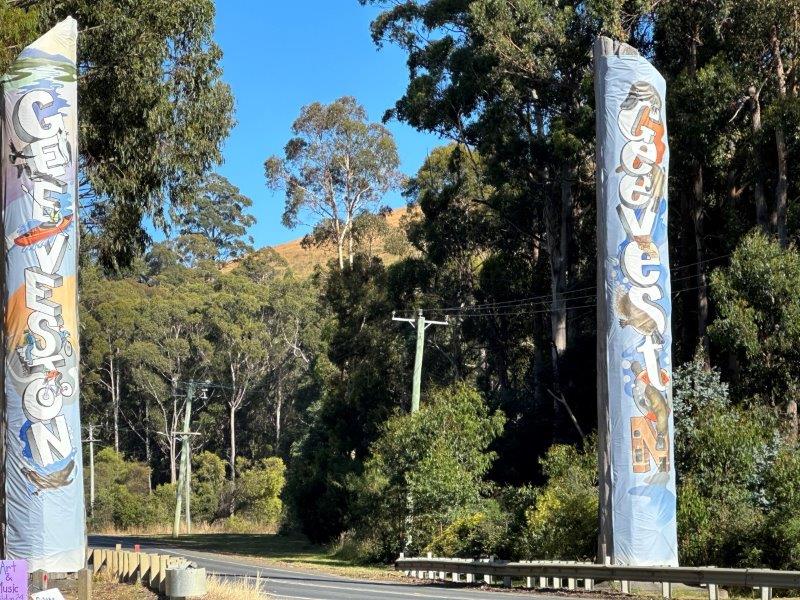
The camping area was next to the Kermandi River. We have heard that you may see the elusive platypus in the river behind our van. After spending some time next to the river, we were lucky to see our first platypus ever. While waiting for the platypus, we met fellow travellers that we stumbled across at least five times during our Tasmanian travels.
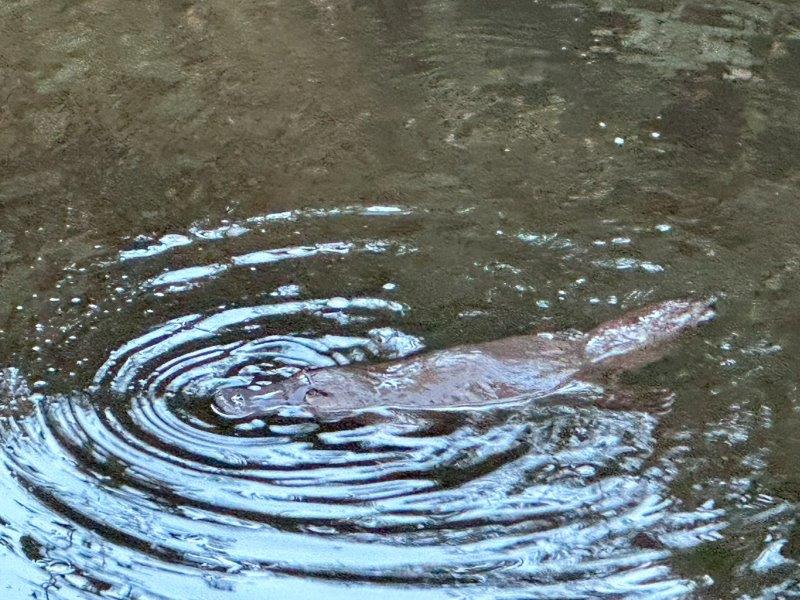
We took a daytrip south from Geeveston, to the most Southern Point of Tasmania (and Australia) by car. The road ends at Cockle Creek with a short walk to the Southern Right Whale Sculpture.

On the way back to the car, we followed the beach where possible.
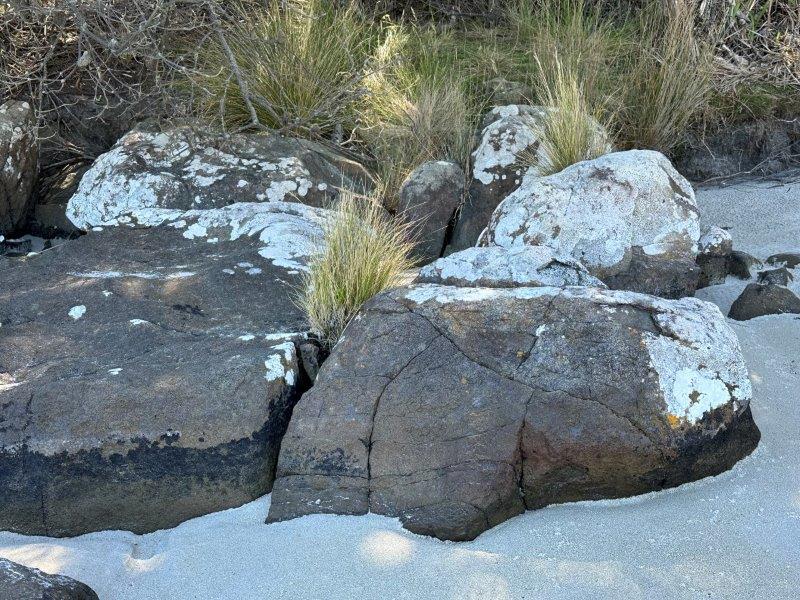
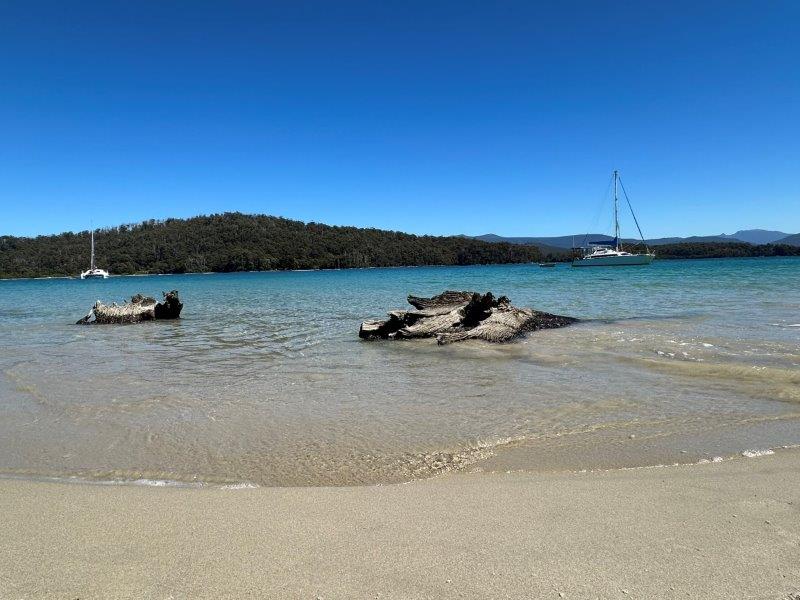
Geeveston is in the Huan valley, renown for apple farming. The Smith family has farmed this land since 1888. Four generations later, they are still apple farmers and cider producers in this area. The Willie Smith’s shed has become a local attraction.
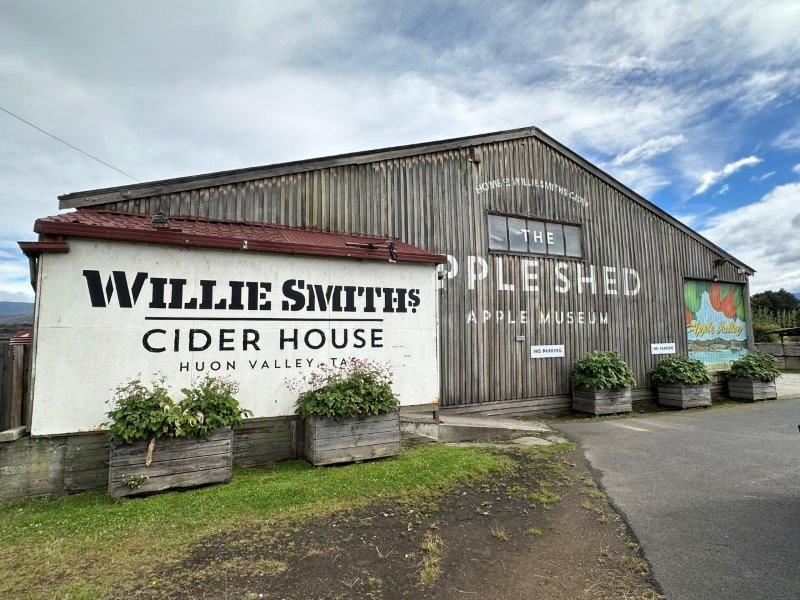
The old packing shed has been converted to a restaurant. This was a great spot to meet good friends from Brisbane, visiting Hobart for a brekky.
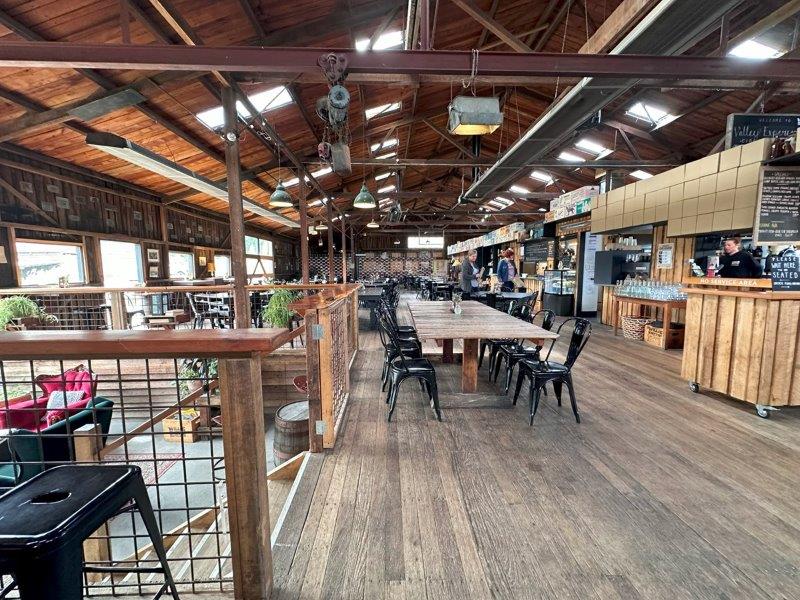
The restaurant and museum is separated by a display of more that 100 apple varieties.
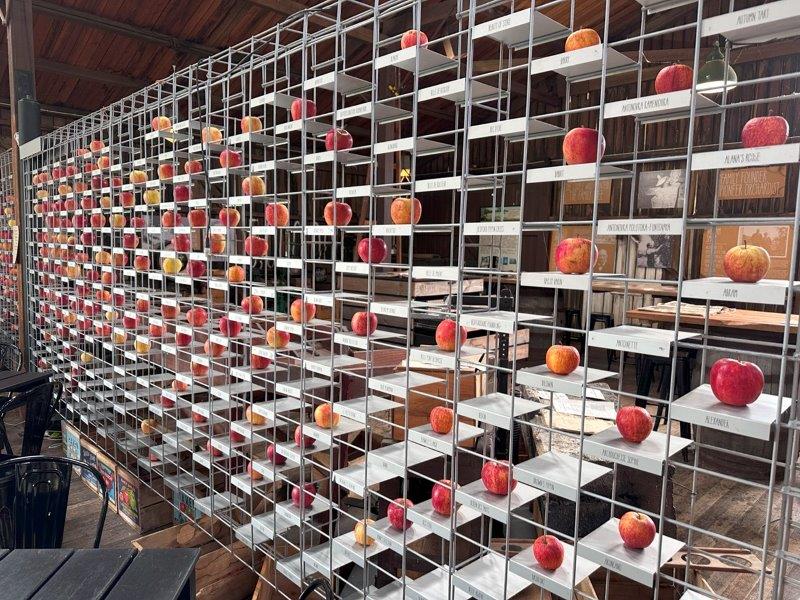
The Museum captures the history from when apples were individually hand wrapped and packed in wooden crates to more modern farming techniques.
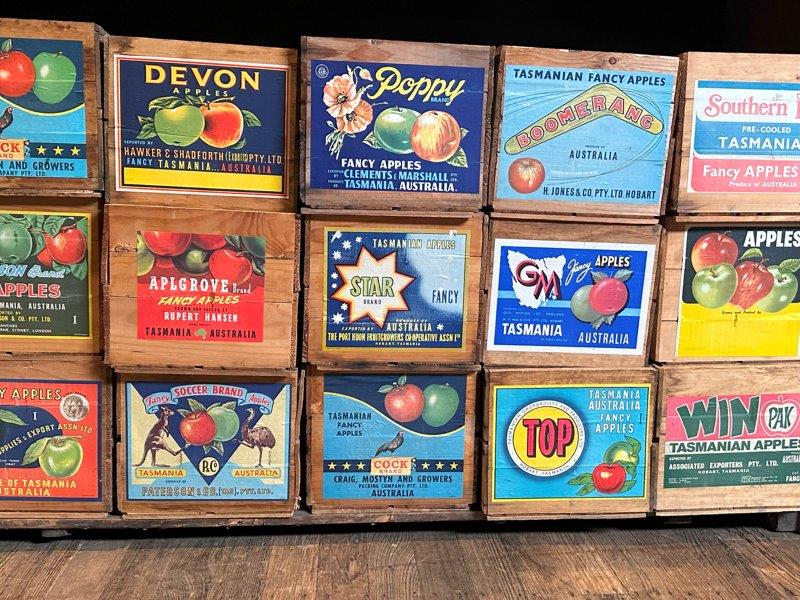
Bruny Island is an island of Tasmania and is about 55km long. There are camping options on the island, but we opted to make it a daytrip. We were up early to arrive second in line for the first ferry from Kettering at 6.10am. The 35 minute ferry ride took us to Roberts Point on the northern part of Bruny island.

The island has a distinct northern and southern part linked with a narrow strip referred to as The Neck. We completed our drive around the northern part of the island before tackling 235 stairs (one way) at The Neck to get a 360 degree view of Bruny.
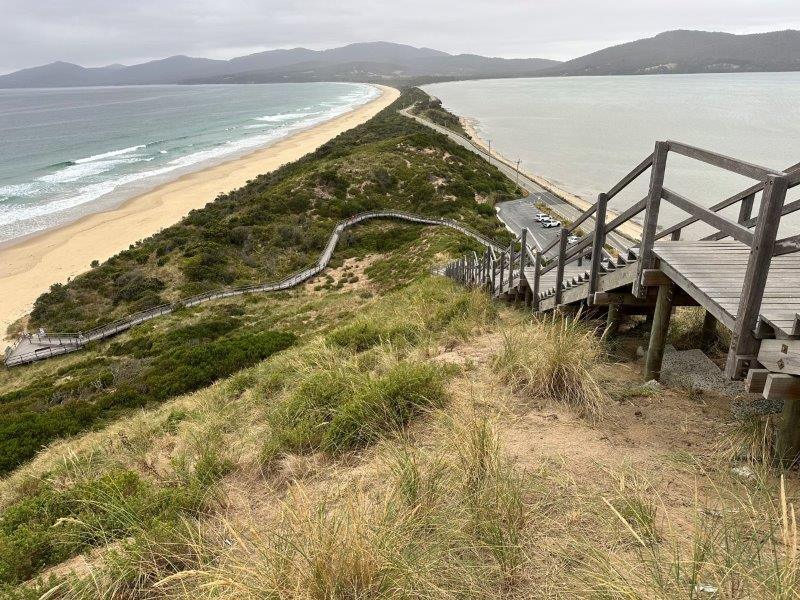
We drove to the eastern part of the island first and came across the Whale Pod Sculpture at one of the coastal settlements.
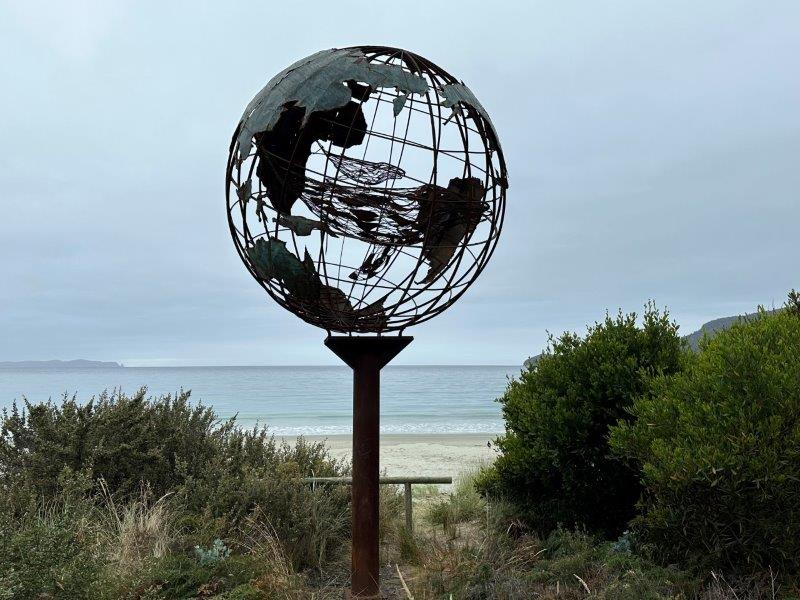
We saw our first white wallaby close to a berry farm on the way south. We never knew they existed.
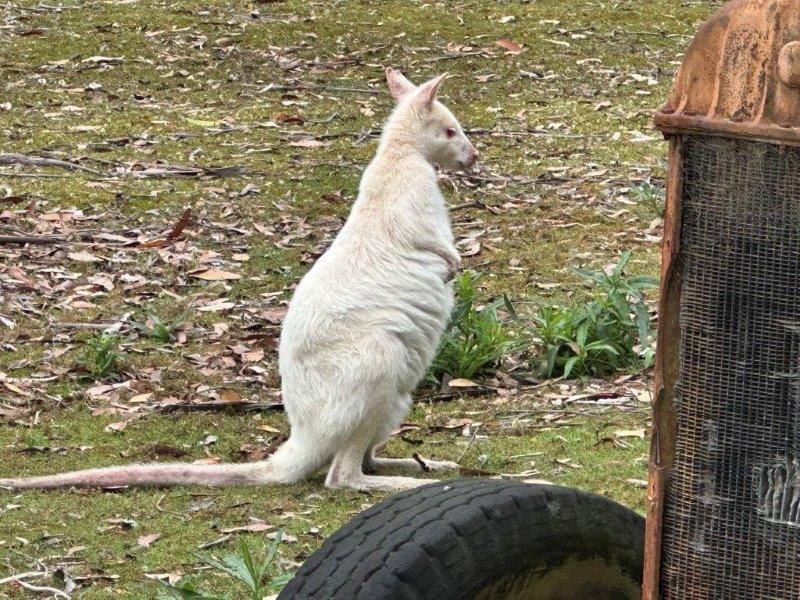
We bought a freshly baked sourdough loaf from this roadside stand for morning tea. We were lucky to see the baker while we were there and even got a hot loaf straight from his basket. Two fridges and a honesty system – my kind of baker. At the top of the fridges you can see the time when the next delivery can be expected.
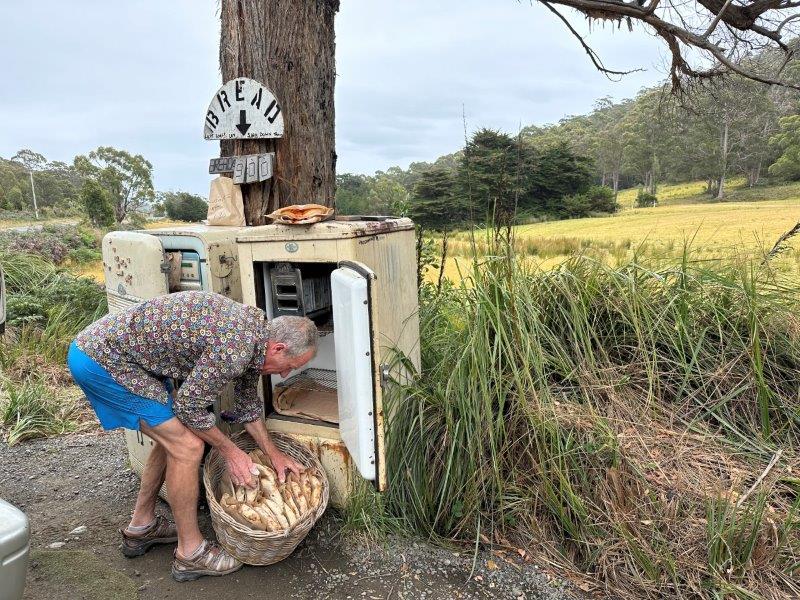
The east coast of Bruny Island is rugged and majestic.
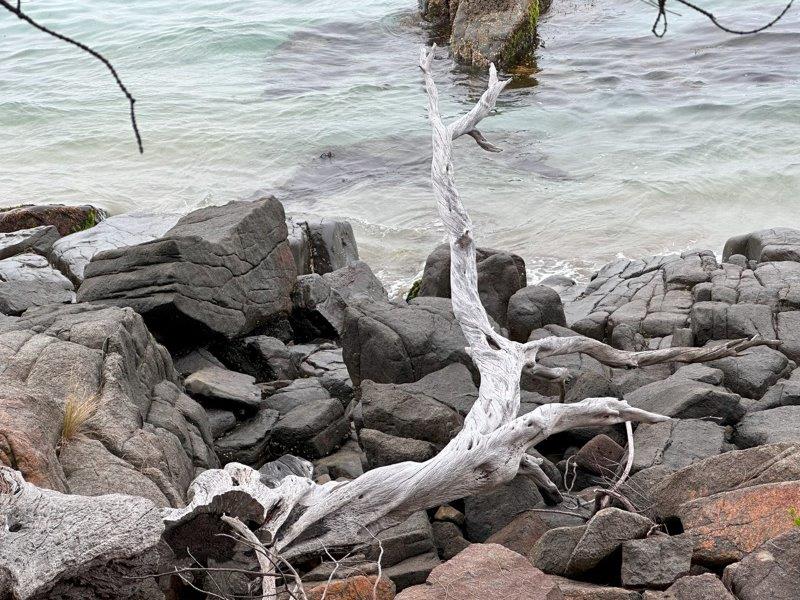
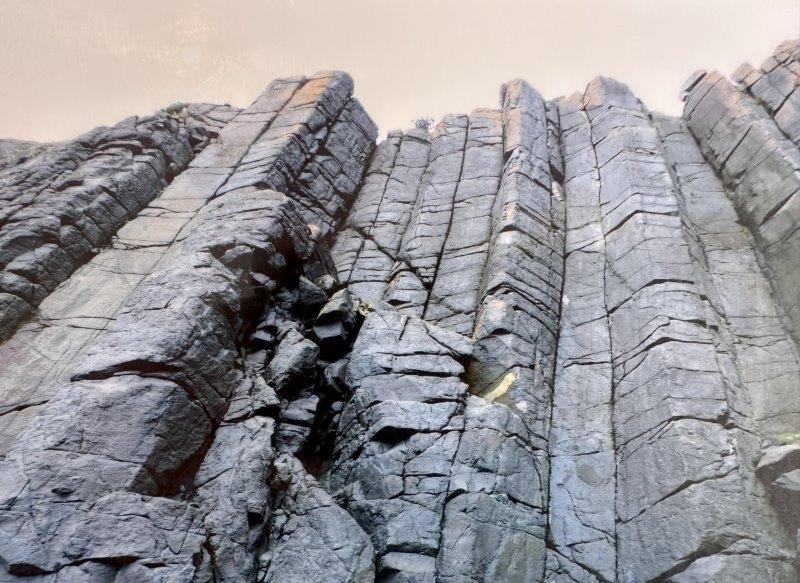
Cape Bruny Lighthouse at the southern point of the island was our favourite part of the island.
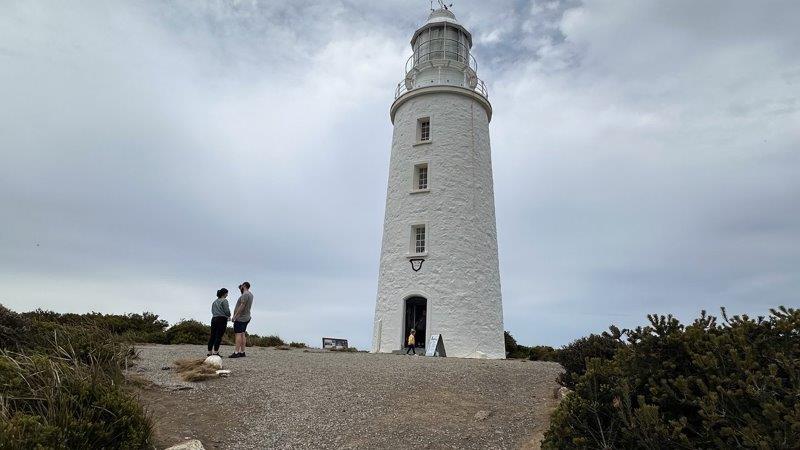
The views over Quiet Bay were great!
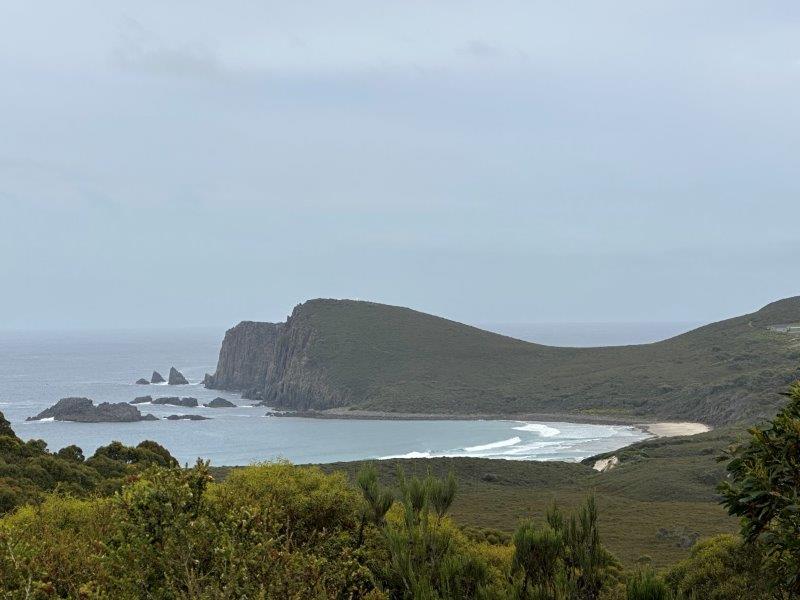
Back in the Huan Valley we stopped at the Wooden Boat Centre in Franklin. Here you can still take courses in boat building. The school is on the Huan River. This is convenient to test if you project floats or fails. There are many fine examples of the work done at the school.
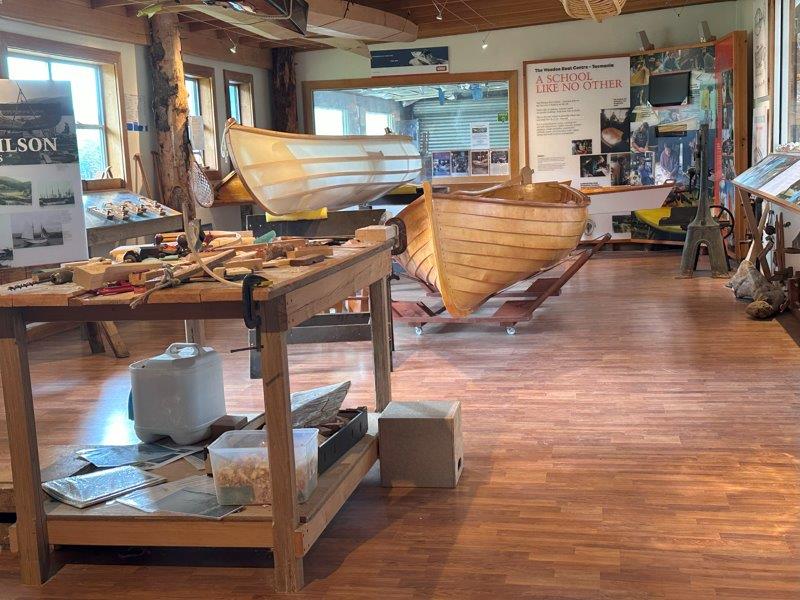
On the way to Mount Wellington we passed the Big Axe at the hotel in Longley.
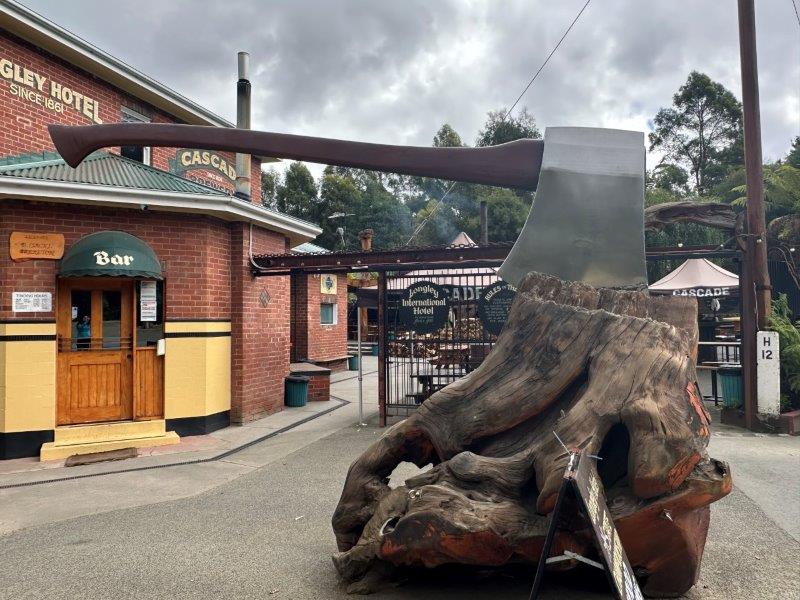
At 4 degrees centigrade, we must have chosen the worst day to go up the mountain.
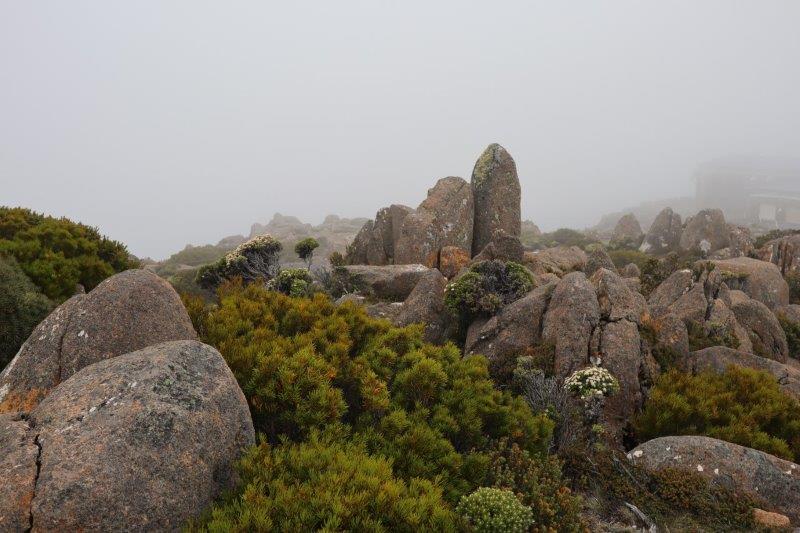
The visibility was poor, even from inside the observation shelter.
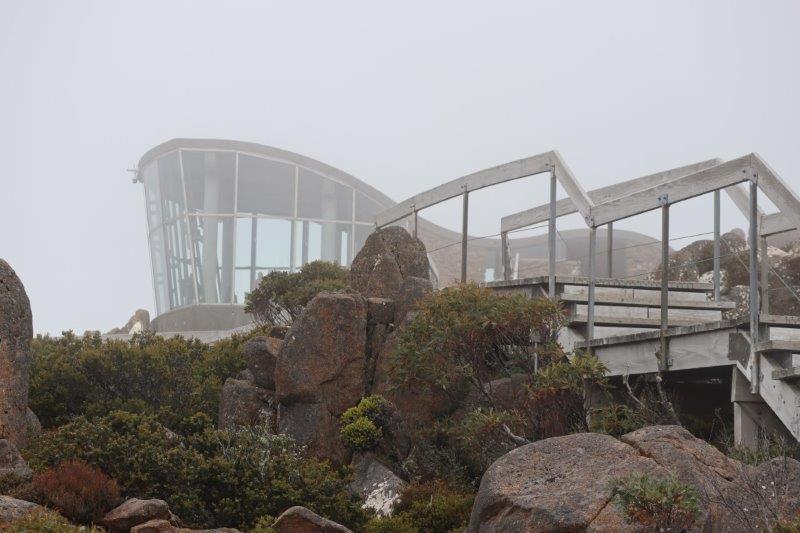
On the way down we caught a few glimpses of Hobart.

Our next focus was Hobart and we started with the Tasmanian Museum and Gallery. Looking at the “Present Being” 2023 by Wona Bae and Charlie Lawler, you feel tempted to try some Domino toppling 🙂
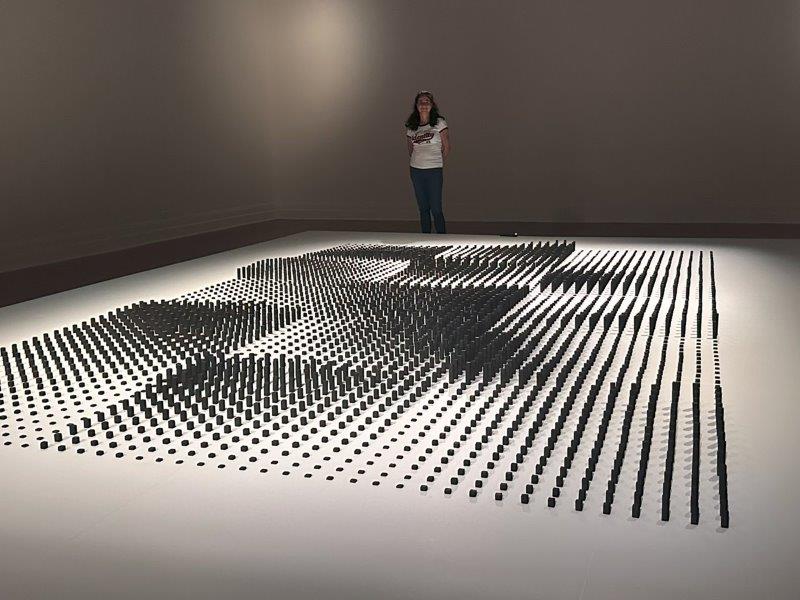
We found parking in Hobart CBD quite challenging, and I even got a parking ticket during our stay. I did appeal it, and got off.
The Royal Tasmanian Botanical Garden provided parking and that was our choice for lunch. It has great views towards the Tasman Bridge.
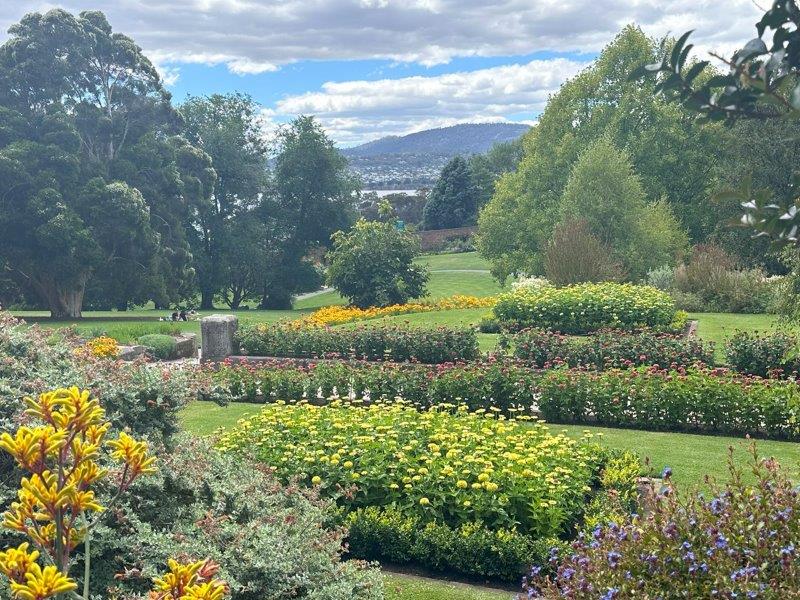
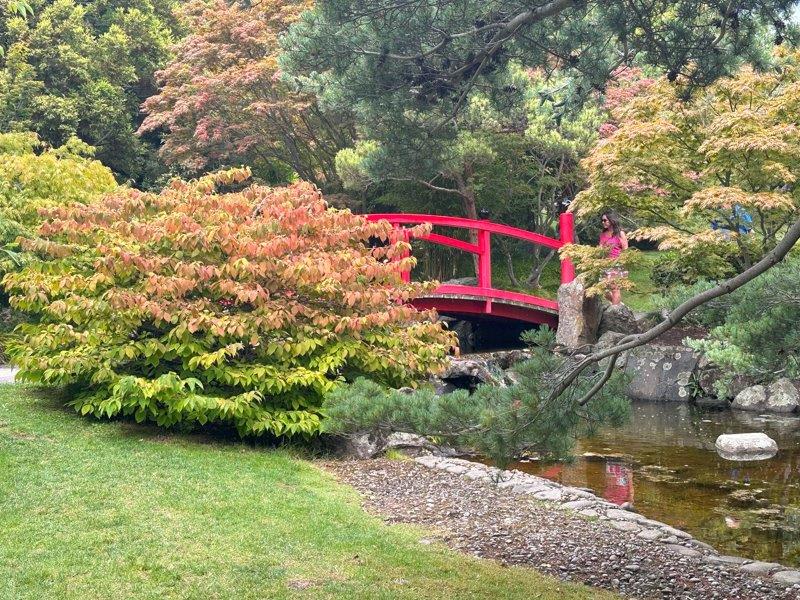
Some of the structures in the garden date back to 1830. More than 100 years later, the sandstone conservatory was built. The Conservatory is a popular venue for weddings and corporate functions.

We have never been in a subantarctic plant house and were certainly not dressed for the occasion. This was very unusual to see in a botanical garden. The chill, fog and mist is complemented by an audio track with arctic and animal sounds. This was great!
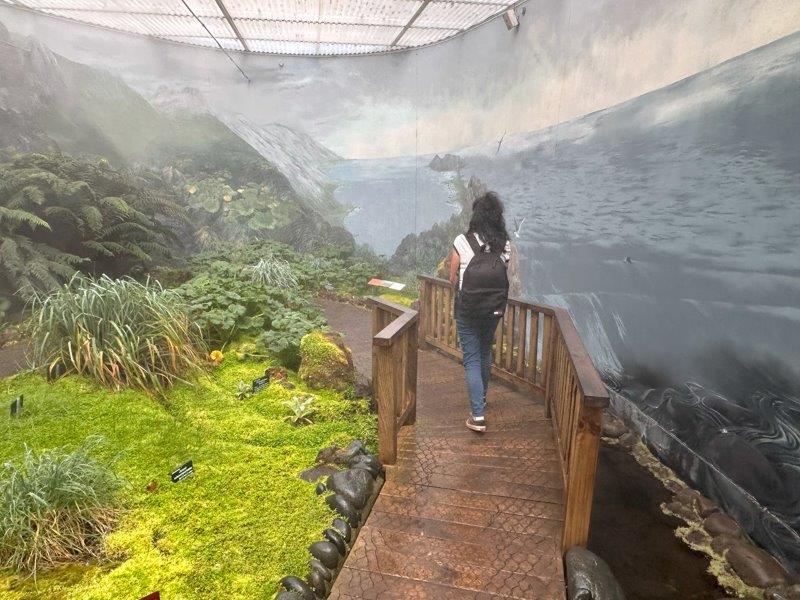
The Hobart Harbour is lined with sculptures, attractions and information on the historic buildings surrounding it.
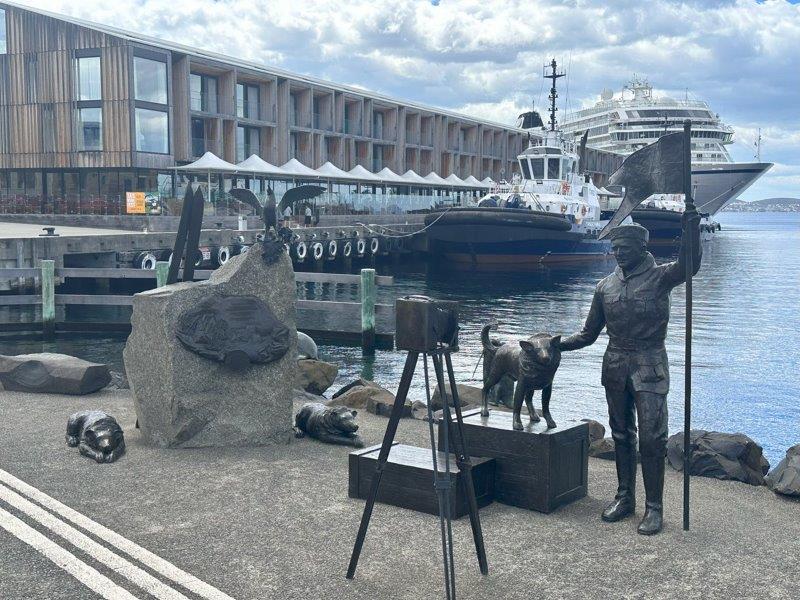
Walking on the Hobart Franklin Wharf reminds you of simpler times with the Windeward Bound tall ship in the background, and…
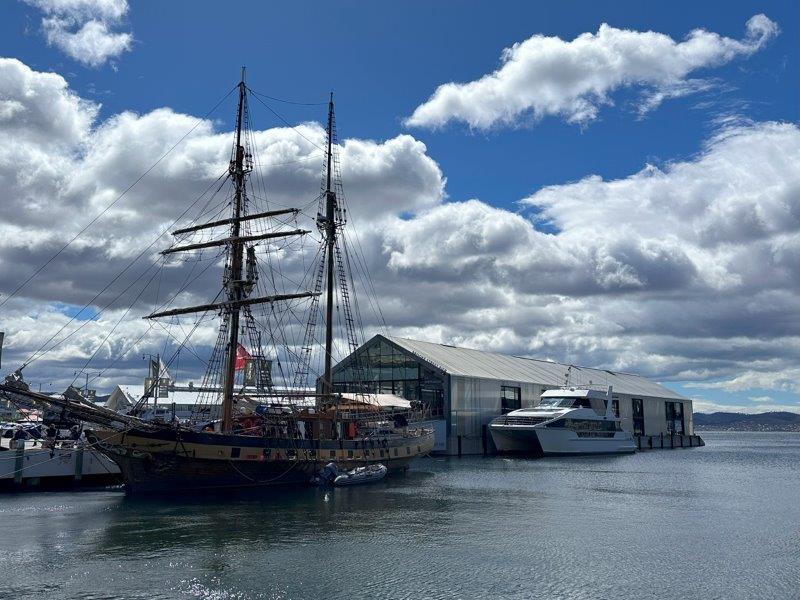
the sound of a Horse drawn cart passing.
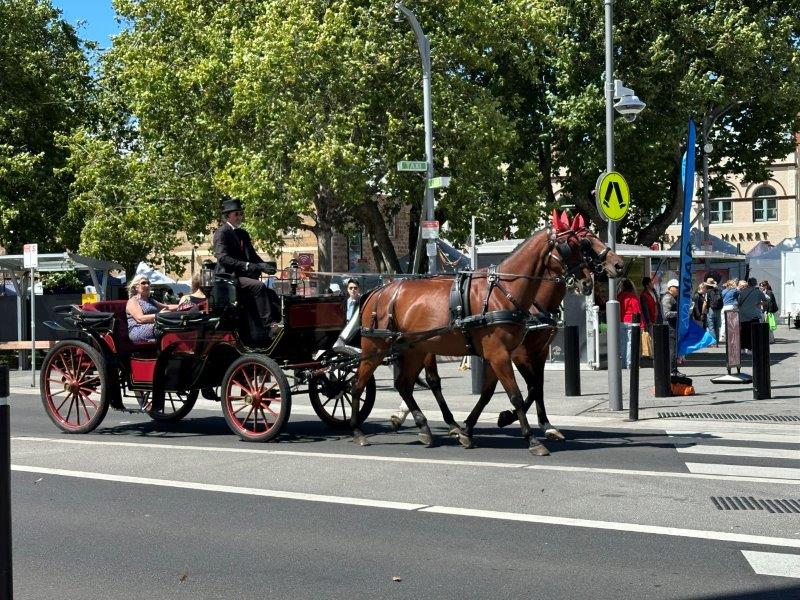
To add to the tranquillity of Hobart, the colourful Salamanca Markets had a constant stream of people meandering through the stalls.
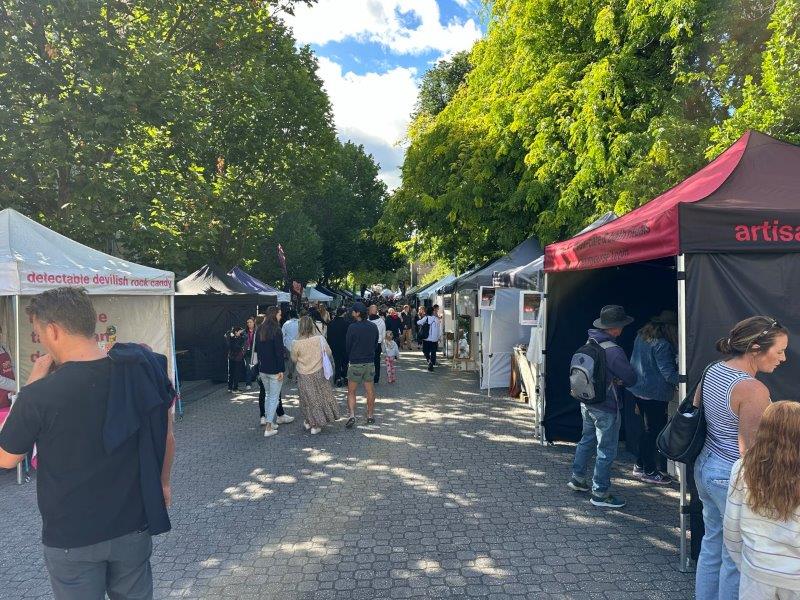
We were lucky to catch up with friends in the shaded gardens next to the market. We even had the obligatory scallop pie. You don’t get more Tasmanian than that 🙂

A narrow old alley links Salamanca Markets with Salamanca Square.
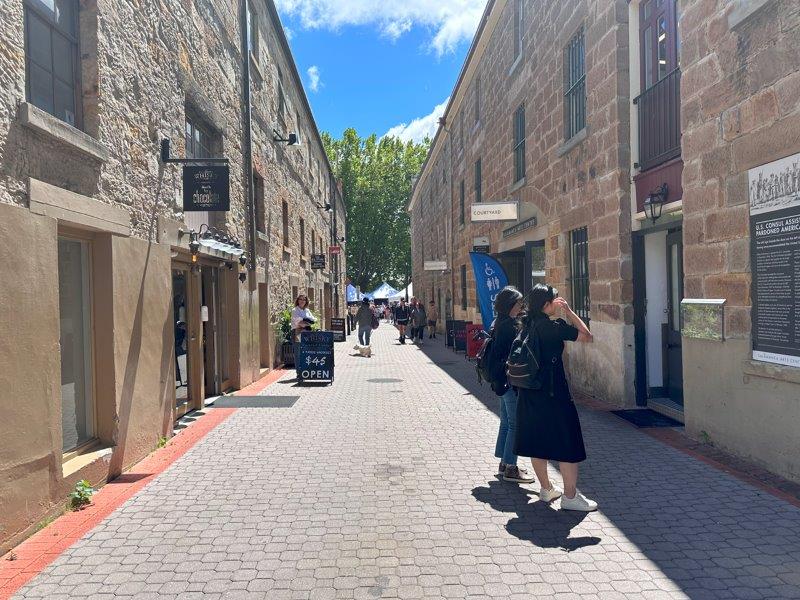
In the square there were many dining options around the large fountain. On display was an artwork depicting Rabbitwoman and Dogman in “Happy Birthday Mr President” by Gillie and Marc. Gillie and Marc were hailed the most successful and prolific creators of public art in New York’s History, by the New York Times.
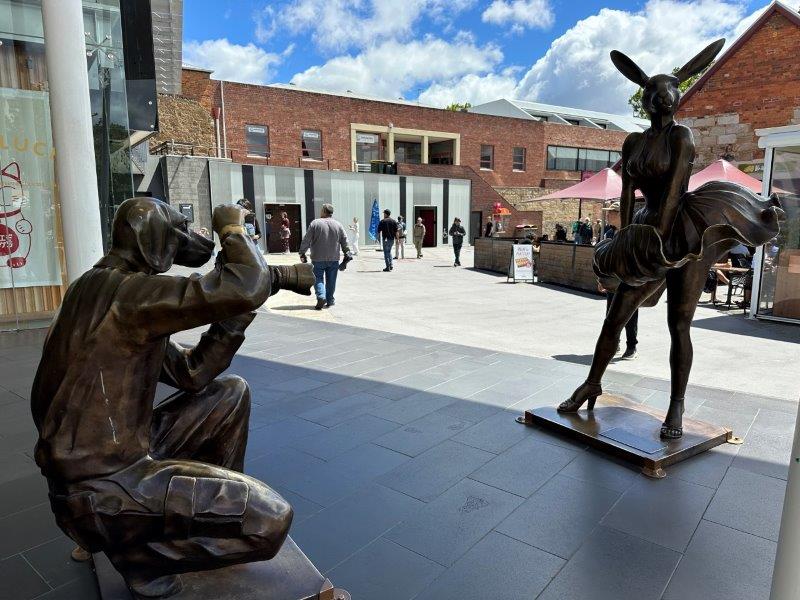
From Hobart we travelled west and again stopped for an impressive historical bridge in Richmond. The Richmond Bridge was build in 1823. And yes, you guessed it… The oldest stone span bridge in Australia was also built by convicts.

The amount of tourists to Richmond and at the bridge was astonishing. Admittedly this is a much larger construction than all of the previous historical bridges we have seen in Tassie.

The main street is lined with old buildings that were meticulously restored.
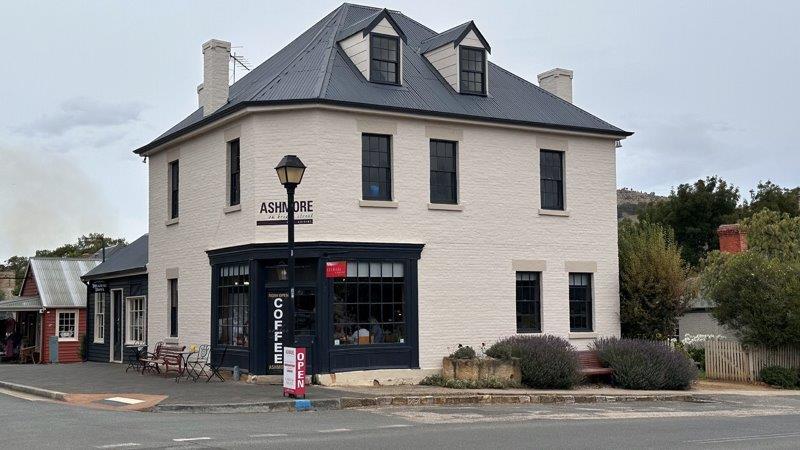
In one of the side streets we visited a shop called The Puzzle People. On wall of the shop was a single puzzle by Ravansburger referred to as the “Mickey” Puzzle. With 40,320 pieces, the staff of the shop engaged some locals to help build this monstrosity measuring 6.8m x 1.9m. It is not just the caravan table that is too small, the total floor of the van is smaller than this puzzle.

Port Arthur is known for its penal settlement dating back to 1830. We had to book and pay in advance to enter the Port Arthur historic site. The ticket provided two days access to explore the vast settlement and also included a harbour cruise. There are many options and guided tours available to enjoy the experience. We condensed our visit into one day and downloaded a podcast giving you information as you walk through the different sites.
After your arrival at reception, you enter a huge information area where you pick a card which pairs you with a convict to follow during your experience during your visit. It doesn’t take long to realise that this settlement has a dark history, despite the tranquil surroundings. This was a settlement designed as an experiment to rehabilitate repeat offenders. The worst of the worst, if you wish. Offences were generally a series of minor crimes committed in the British Empire. Transportation of convicts to Port Arthur ended in 1853.
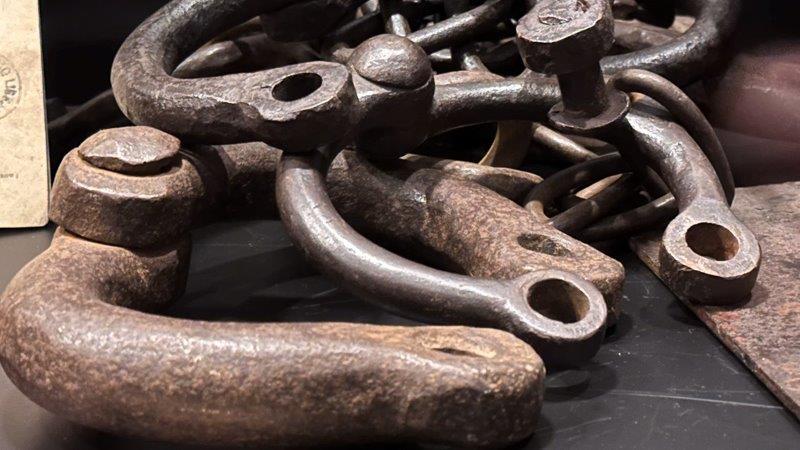
This was not just a jail but a settlement with a church, schooling, agricultural and other activities. With its own harbour, it was conveniently close to Hobart to stock up on supplies by ship.
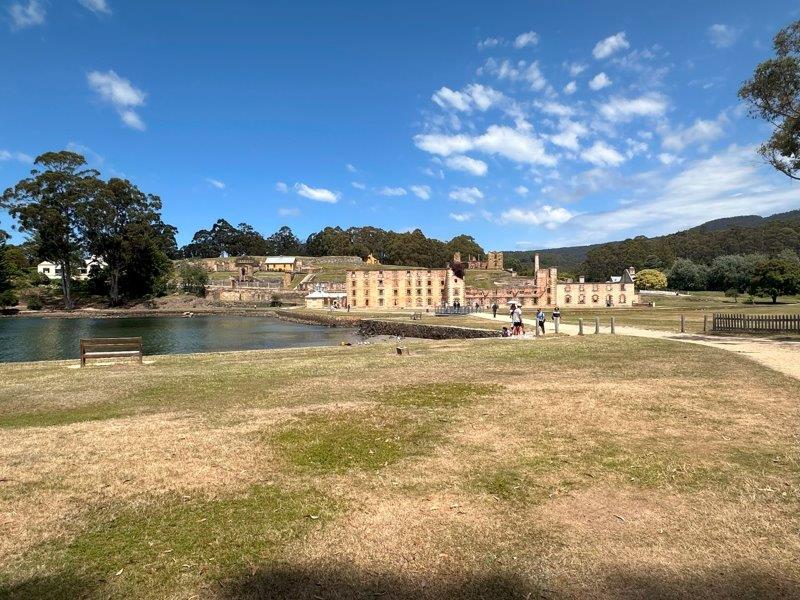
People were not just jailed here, but also participated in forced labour and were able to learn new skills that may be useful outside of prison to assist in building the Empire. There were different techniques used to rehabilitate the convicts. These included old fashioned jailing combined with hard labour, but also experimental psychological trials for difficult convicts.
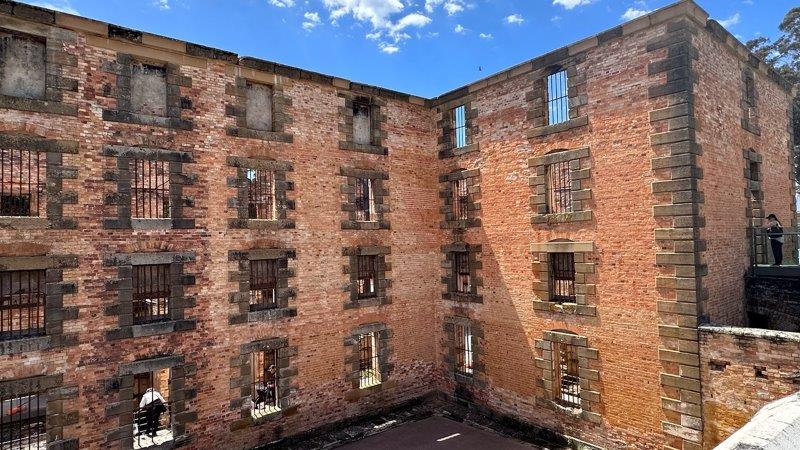
The walls of the old church is another significant old building. There is a somewhat gothic vibe walking amongst the old ruins.

The guards’ watchtower was positioned to have visibility over the penitentiary and the harbour.
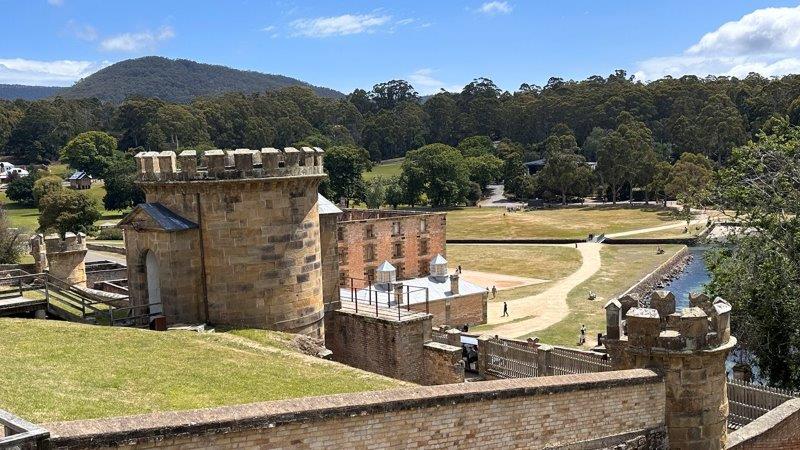
In contrast to the dark history, we found many old fruit trees, orchids and beautiful waking lanes.
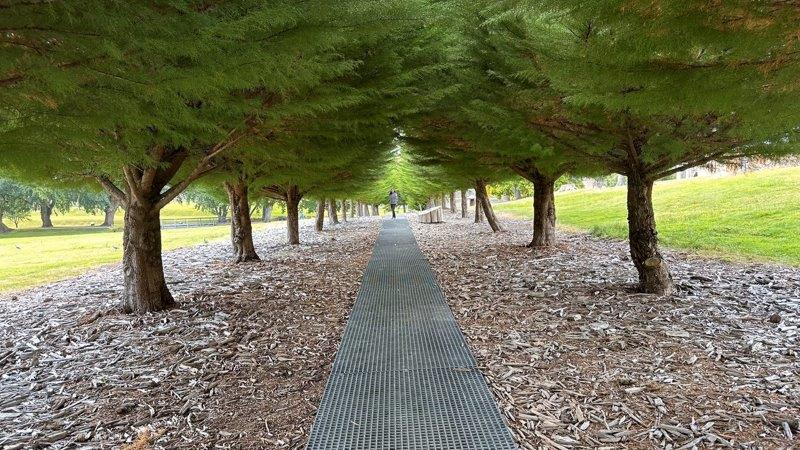
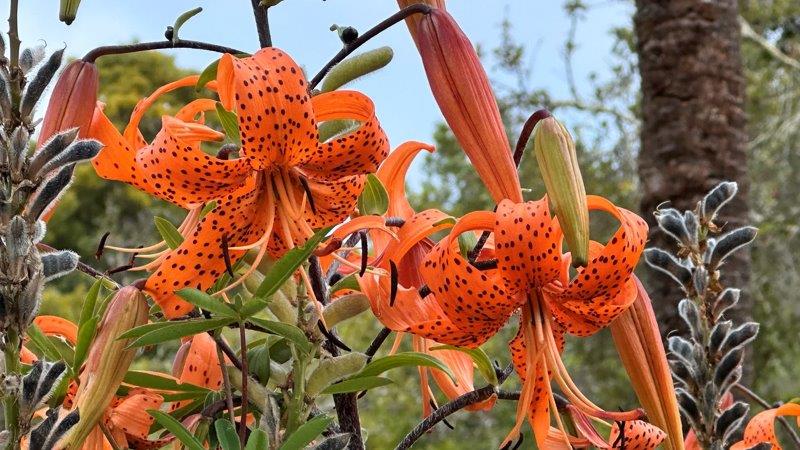
The harbour cruise takes you around the Isle of the Dead and points out other significant sites to the colony, only accessible by sea.
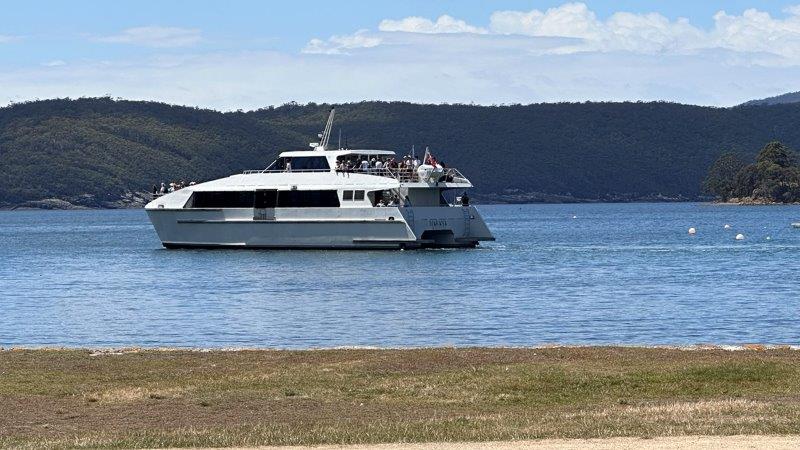
Almost 1100 people were buried on the Isle of the Dead.
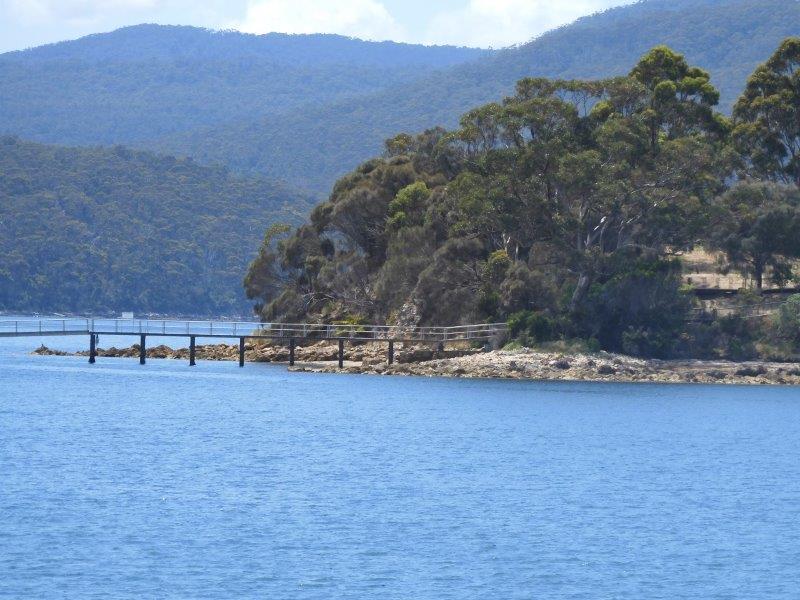
The view sailing back to the harbour was spectacular.
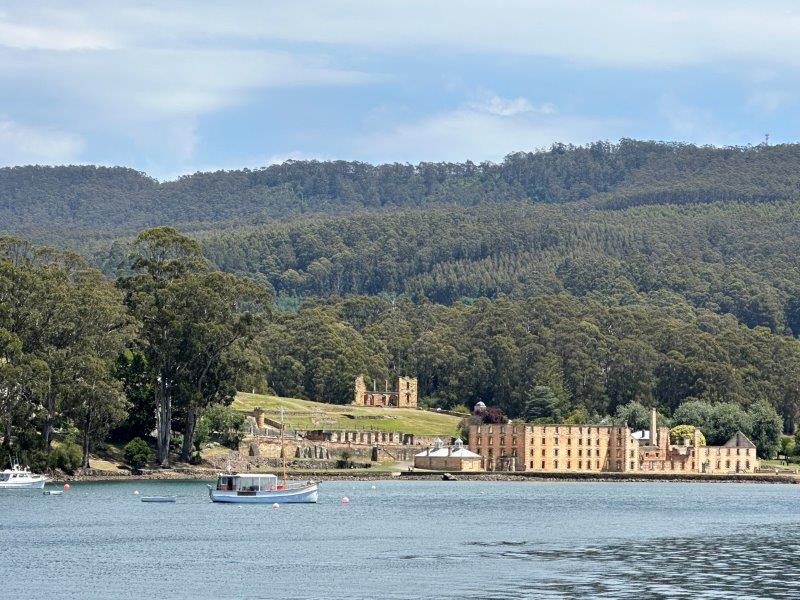
On the way out of the settlement, we stopped at the memorial for the Port Arthur Massacre. On 28 April 1996, a gunman killed 35 visitors to the settlement. The gunman, Martin Bryant, got 35 life sentences. This massacre did influence and change the Australian gun laws.
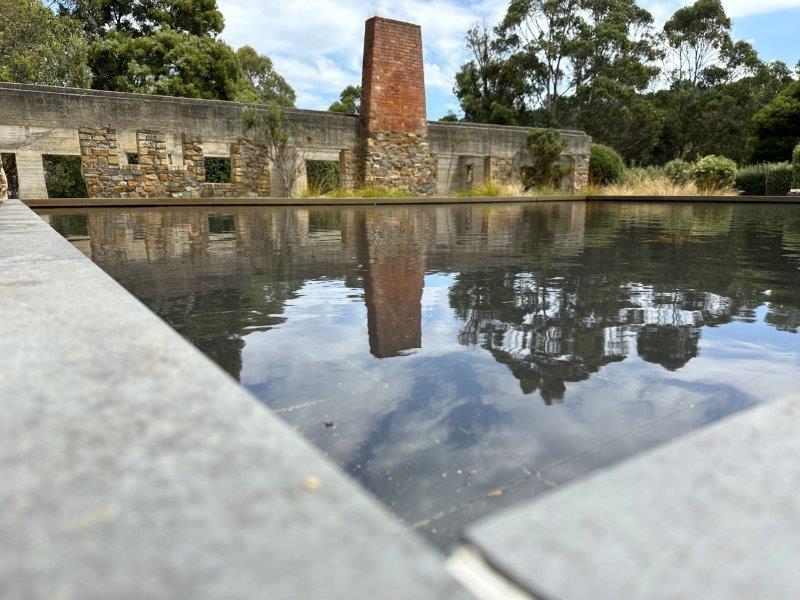
The names of the 35 victims are captured at the memorial site on a plaque.
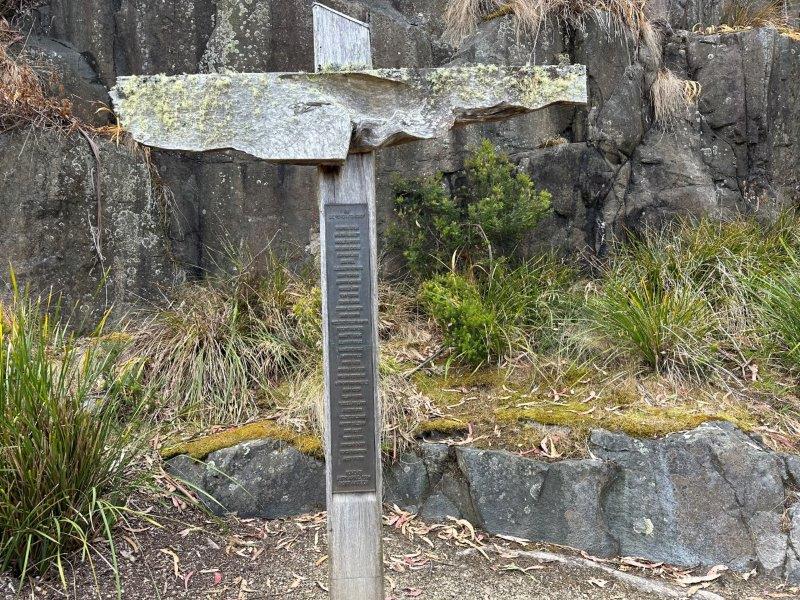
Many of the “marked men” ended up at the Convict Coal Mine. The site is about 23 km from the main jail. When we visited the mine, most buildings we merely ruins. Some of the underground cells were still in tact.
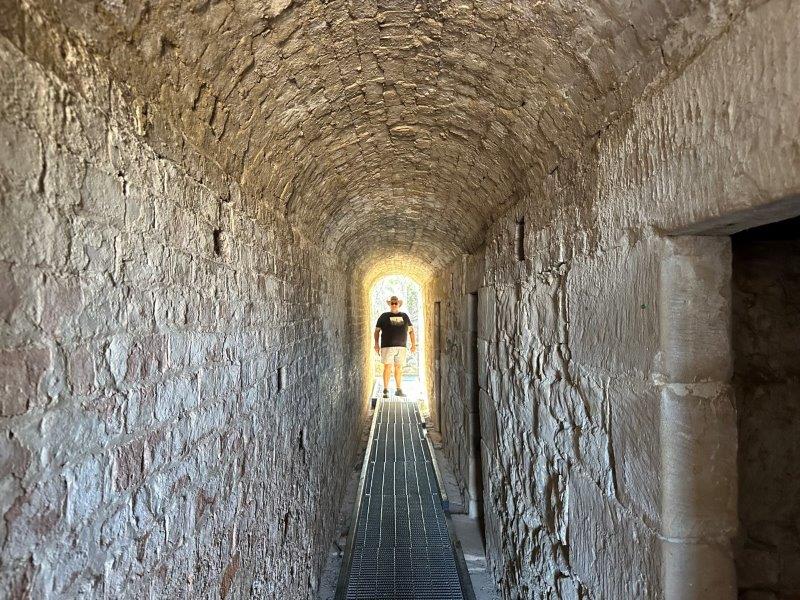
Before heading home, we did a short detour to the Remarkable Cave. On the way, we had a great view on Cape Raoul over Basket Bay.
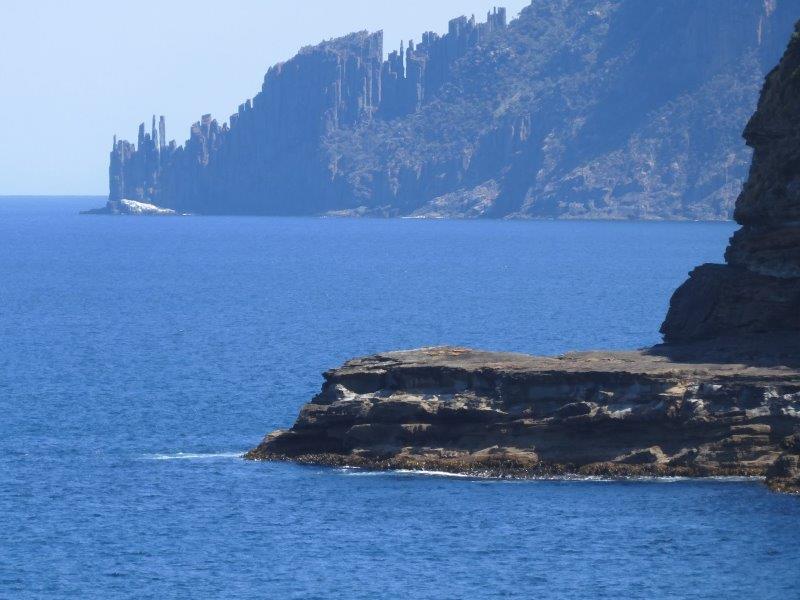
After descending more than 100 stairs, we got to Remarkable Cave.

This concluded the south eastern coast of Tasmania. From here we headed north in the direction of the well know Bay of Fires.

